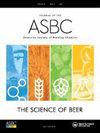啤酒生产中商品菌株的评价
IF 1.8
4区 农林科学
Q4 BIOTECHNOLOGY & APPLIED MICROBIOLOGY
Journal of the American Society of Brewing Chemists
Pub Date : 2022-02-15
DOI:10.1080/03610470.2021.2025327
引用次数: 2
摘要
摘要如今,微酿酒工业的目标是酿酒酵母以外的酵母菌株,即所谓的非酿酒酵母,因为它们对最终产品的风味贡献。在本研究中,在13岁和20岁时,在与酿酒酵母的单培养和共培养发酵中,评估了两种德氏Torulaspora delbrueckii商业菌株(Prelude和291)生产淡啤酒的能力 °C。从结果中可以得出结论,两种非酿酒酵母都能够在两种温度下代谢麦芽糖,尽管在13℃时代谢速度较慢 °C。将发酵产物密封在玻璃瓶中(无需过滤),并在30分钟后测量乙醇含量、颜色、苦味和挥发性化合物 储存天数。从非酿酒酵母单培养物中获得的乙醇含量在3.90至5.50%酒精体积(ABV)之间变化,而共培养物的乙醇含量与传统酵母获得的乙醇浓度(4.80至5.80%ABV)没有显著差异。在非酿酒酵母发酵中检测到较高的苦味和色度值。挥发性化合物的分析表明,这两种非传统酵母能够产生芳香成分,如高级醇和酯类,产生果味和花香,尤其是在T.delbrueckii 291在13 °C。本文章由计算机程序翻译,如有差异,请以英文原文为准。
Evaluation of Commercial Strains of Torulaspora delbrueckii in Beer Production
Abstract Nowadays, the micro-brewing industry aims at yeast strains beyond Saccharomyces cerevisiae, the so-called non-Saccharomyces, for their flavor contribution to the final product. In the present study, two commercial strains of Torulaspora delbrueckii (Prelude and 291) were evaluated for the production of a pale ale beer, in mono- and co-culture fermentations with S. cerevisiae, at 13 and 20 °C. From the results, it was concluded that both non-Saccharomyces yeasts were able to metabolize wort sugars at both temperatures, albeit at a slower rate at 13 °C. The fermented products were sealed in glass bottles (without filtration) and measurements of the ethanol content, color, bitterness, and volatile compounds were conducted after 30 days of storage. The ethanol content obtained from the non-Saccharomyces monocultures varied between 3.90 and 5.50% alcohol by volume (ABV), while that of the co-cultures was not significantly different from the ethanol content obtained by the conventional yeast (4.80–5.80% ABV). Higher bitterness and color values were detected in the non-Saccharomyces fermentations. The analysis of volatile compounds revealed that the two non-conventional yeasts were capable of producing aromatic components, such as higher alcohols and esters, yielding a fruity and floral aromatic profile, especially in the mixed culture fermentation of T. delbrueckii 291 at 13 °C.
求助全文
通过发布文献求助,成功后即可免费获取论文全文。
去求助
来源期刊

Journal of the American Society of Brewing Chemists
工程技术-生物工程与应用微生物
CiteScore
4.00
自引率
20.00%
发文量
41
审稿时长
3 months
期刊介绍:
The Journal of the American Society of Brewing Chemists publishes scientific papers, review articles, and technical reports pertaining to the chemistry, microbiology, and technology of brewing and distilling, as well as the analytical techniques used in the malting, brewing, and distilling industries.
 求助内容:
求助内容: 应助结果提醒方式:
应助结果提醒方式:


